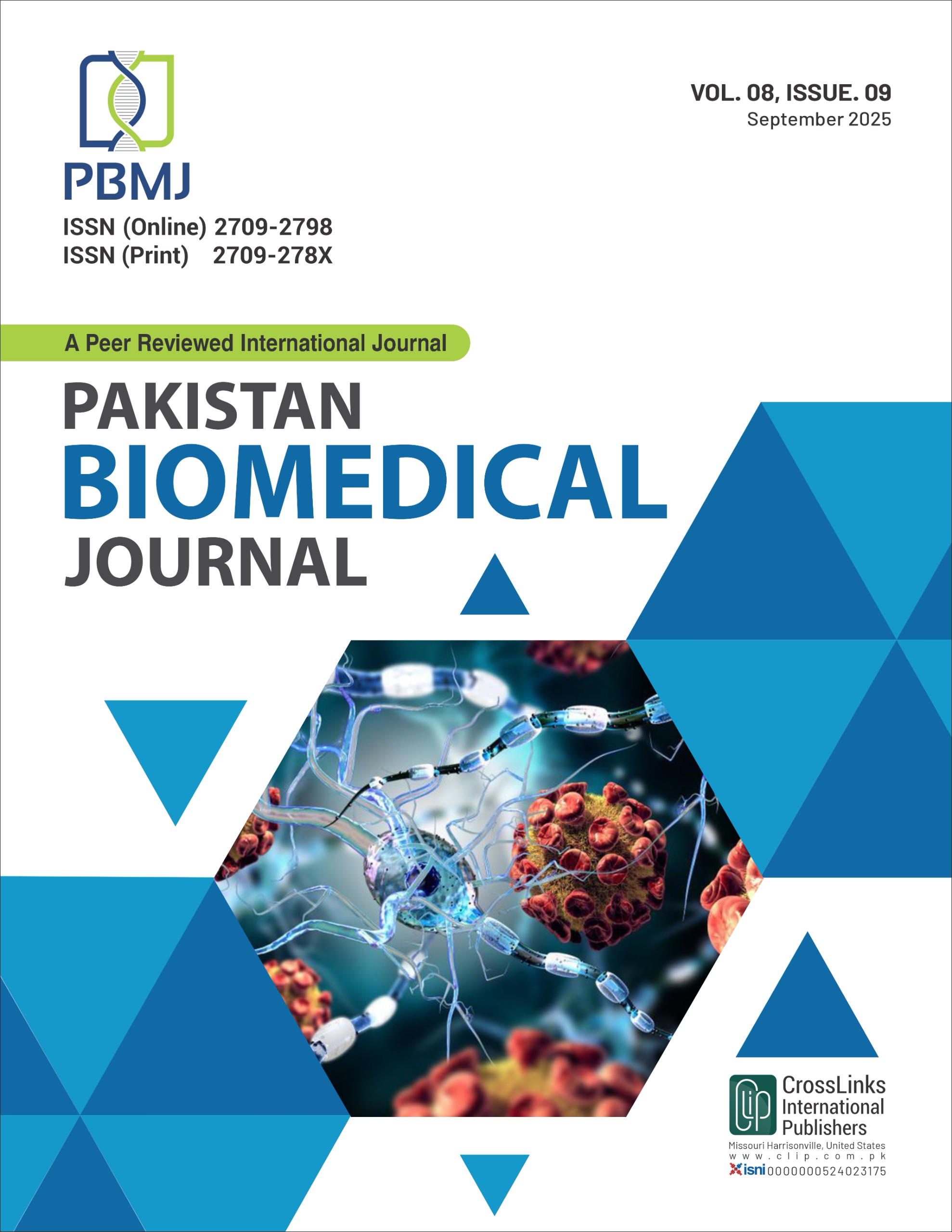Serum Electrolytes and Their Combined Effect on Hyperuricemia among Type 2 Diabetic Patients
Serum Electrolytes and Hyperuricemia among Type 2 Diabetic Patients
DOI:
https://doi.org/10.54393/pbmj.v8i9.1298Keywords:
Hyperuricemia, Type 2 Diabetes Mellitus, Serum Electrolytes, Magnesium, PotassiumAbstract
Hyperuricemia (HU) is a metabolic and kidney dysfunction that is rapidly prevailing. To compare the diabetic, gender, and age-based response of magnesium and potassium in patients with diabetes mellitus (DM) type 2. Objectives: To compare the diabetic, gender, and age-based response of magnesium and potassium in patients with diabetes mellitus (DM) type 2. Methods: It was a randomized controlled trial (single-blinded) conducted on 290 patients. Four groups were formed: T1 (control), T2 (Magnesium), T3 (Potassium), and T4 (Magnesium + Potassium). Supplements were given for a period of two months. Blood samples from subjects were taken before (phase I) and after (phase II) the supplements. Unpaired t-test and multivariate Analysis of Variance (MANOVA) were applied. Results: Among 290 participants, 195 were female (67.2%) and 95 male (32.7%), with 159 (54.8%) of all participants in the age range of 46-65 years. The mean uric acid levels dropped from 5.5 mg/dL to 4.6 mg/dL after medication intervention. Significant differences in BSF/R, HbA1c, and uric acid levels were reported between phase I and phase II; p-values <0.001, 0.0025, and 0.04, respectively. MANOVA determined that T3 was highly significant with respect to gender (0.005) and T4 with respect to age (0.01). While the control group showed the largest absolute drop in uric acid, potassium supplementation (T3) demonstrated a consistent and statistically significant reduction relative to baseline and across gender groups. Conclusions: Potassium substantially plays an effective role in lowering the BSF/R and uric acid levels of T2DM patients and is controlled by gender.
References
Alqubaty AR, Alhaj A, Al-qadasi F. Serum Electrolyte Levels among Patients with Type 2 Diabetes Mellitus in Sana’a City, Yemen. Zagazig University Medical Journal. 2022 Nov; 28(6): 1305-11.
Aktas G, Kocak MZ, Bilgin S, Atak BM, Duman TT, Kurtkulagi O. Uric acid to HDL Cholesterol Ratio Is A Strong Predictor of Diabetic Control in Men with Type 2 Diabetes Mellitus. The Aging Male. 2020 Dec; 23(5): 1098-102. doi: 10.1080/13685538.2019.1678126. DOI: https://doi.org/10.1080/13685538.2019.1678126
Ma CX, Ma XN, Guan CH, Li YD, Mauricio D, Fu SB. Cardiovascular Disease in Type 2 Diabetes Mellitus: Progress Toward Personalized Management. Cardiovascular Diabetology. 2022 May; 21(1): 74. doi: 10.1186/s12933-022-01516-6. DOI: https://doi.org/10.1186/s12933-022-01516-6
Chen XY, Lu F, Zhang J, Xu CX, Du XF, Liang MB et al. The Effect of Hyperuricemia and Its Interaction with Hypertension Towards Chronic Kidney Disease in Patients with Type 2 Diabetes: Evidence from A Cross-Sectional Study in Eastern China. Frontiers in Endocrinology. 2024 Jul; 15: 1415459. doi: 10.3389/fendo.2024.1415459. DOI: https://doi.org/10.3389/fendo.2024.1415459
Sluijs I, Beulens JW, Spijkerman AM, Schulze MB, Van der Schouw YT. Plasma Uric Acid Is Associated with Increased Risk of Type 2 Diabetes Independent of Diet and Metabolic Risk Factors. The Journal of Nutrition. 2013 Jan; 143(1): 80-5. doi: 10.3945/jn.112.167221. DOI: https://doi.org/10.3945/jn.112.167221
Du L, Zong Y, Li H, Wang Q, Xie L, Yang B et al. Hyperuricemia and Its Related Diseases: Mechanisms and Advances in Therapy. Signal Transduction and Targeted Therapy. 2024 Aug; 9(1): 212. doi: 10.1038/s41392-024-01916-y. DOI: https://doi.org/10.1038/s41392-024-01916-y
Wardhana W and Rudijanto A. Effect of Uric Acid on Blood Glucose Levels. Acta Med Indones. 2018 Jul; 50(3): 253-6.
Bohara J, Kunwar S, Poudel GA, Joshi SR, Gurung S. Serum Electrolytes Disturbances in Type 2 Diabetic Patients. The International Journal of Health Sciences and Research. 2021; 11(7): 105-10. doi: 10.52403/ijhsr.20210715. DOI: https://doi.org/10.52403/ijhsr.20210715
Khan A, Naveed A, Taimoor AK, Azadi K, Sana I, Mehreen AK. Comparison of Acid Base Status and Electrolytes in Individuals with Prediabetes, Diabetes and Normoglycemia. Pakistan Armed Forces Medical Journal. 2023; 73: S344-47. doi: 10.51253/pafmj.v73iSUPPL-1.5491. DOI: https://doi.org/10.51253/pafmj.v73iSUPPL-1.5491
Farooq M, Ijaz A, Tabasum N, Nasir S, Shahzad M, Khurram S et al. Correlation of HbA1c with Serum Electrolytes in Patients with Type-II Diabetes Mellitus and Their Associated Risk Factors. General Medicine. 2024; 26: 1865-73.
Soriano-Pérez L, Aranda-Rivera AK, Cruz-Gregorio A, Pedraza-Chaverri J. Magnesium and Type 2 Diabetes Mellitus: Clinical and Molecular Mechanisms. Health Sciences Review. 2022 Sep; 4: 100043. doi: 10.1016/j.hsr.2022.100043. DOI: https://doi.org/10.1016/j.hsr.2022.100043
Piuri G, Zocchi M, Della Porta M, Ficara V, Manoni M et al. Magnesium in Obesity, Metabolic Syndrome, and Type 2 Diabetes. Nutrients. 2021 Feb; 13(2): 320. doi: 10.3390/nu13020320. DOI: https://doi.org/10.3390/nu13020320
Bilancio G, Cavallo P, Lombardi C, Guarino E, Cozza V, Giordano F et al. Saliva for Assessing Creatinine, Uric Acid, and Potassium in Nephropathic Patients. BioMed Central Nephrology. 2019 Jul; 20(1): 242. doi: 10.1186/s12882-019-1437-4. DOI: https://doi.org/10.1186/s12882-019-1437-4
Shiyovich A, Gilutz H, Plakht Y. Serum Electrolyte/Metabolite Abnormalities among Patients with Acute Myocardial Infarction: Comparison Between Patients with and without Diabetes Mellitus. Postgraduate Medicine. 2021 May; 133(4): 395-403. doi: 10.1080/00325481.2020.1860393. DOI: https://doi.org/10.1080/00325481.2020.1860393
Xu Y, Zhu J, Gao L, Liu Y, Shen J, Shen C et al. Hyperuricemia as an Independent Predictor of Vascular Complications and Mortality in Type 2 Diabetes Patients: A Meta-Analysis. PLOS One. 2013 Oct; 8(10): e78206. doi: 10.1371/journal.pone.0078206. DOI: https://doi.org/10.1371/journal.pone.0078206
Abudureyimu P, Pang Y, Huang L, Luo Q, Zhang X, Xu Y et al. A Predictive Model for Hyperuricemia among Type 2 Diabetes Mellitus Patients in Urumqi, China. BioMed Central Public Health. 2023 Sep; 23(1): 1740. doi: 10.1186/s12889-023-16669-6. DOI: https://doi.org/10.1186/s12889-023-16669-6
Wang Y and Lu J. The Management of Diabetes with Hyperuricemia: Can We Hit Two Birds with One Stone? Journal of Inflammation Research. 2023 Dec: 6431-41. doi: 10.2147/JIR.S433438. DOI: https://doi.org/10.2147/JIR.S433438
Chou P, Lin KC, Lin HY, Tsai ST. Gender Differences in the Relationships of Serum Uric Acid with Fasting Serum Insulin and Plasma Glucose in Patients Without Diabetes. The Journal of Rheumatology. 2001 Mar; 28(3): 571-6.
Woldeamlak B, Yirdaw K, Biadgo B. Hyperuricemia and Its Association with Cardiovascular Disease Risk Factors in Type Two Diabetes Mellitus Patients at the University of Gondar Hospital, Northwest Ethiopia. Ejifcc. 2019 Oct; 30(3): 325.
Chiou WK, Wang MH, Huang DH, Chiu HT, Lee YJ, Lin JD. The Relationship Between Serum Uric Acid Level and Metabolic Syndrome: Differences by Sex and Age in Taiwanese. Journal of Epidemiology. 2010 May; 20(3): 219-24. doi: 10.2188/jea.JE20090078. DOI: https://doi.org/10.2188/jea.JE20090078
Downloads
Published
How to Cite
Issue
Section
License
Copyright (c) 2025 Pakistan BioMedical Journal

This work is licensed under a Creative Commons Attribution 4.0 International License.
This is an open-access journal and all the published articles / items are distributed under the terms of the Creative Commons Attribution License, which permits unrestricted use, distribution, and reproduction in any medium, provided the original author and source are credited. For comments editor@pakistanbmj.com











